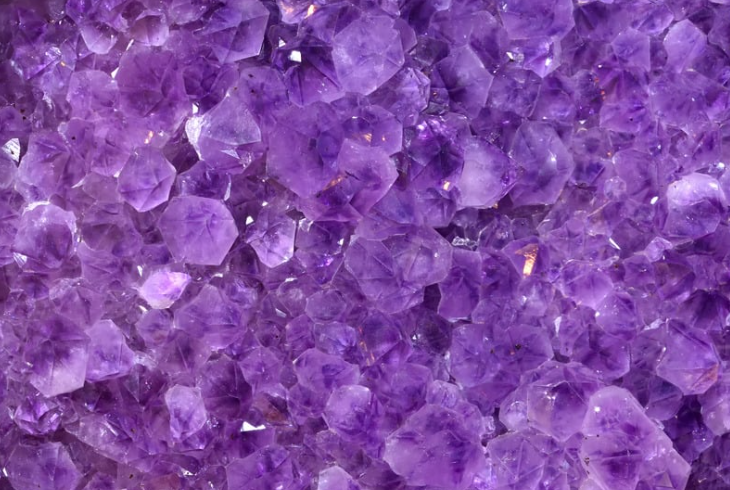
Amethyst: Mineral & Myth
Share
Ask anyone to think of a crystal, and there’s a pretty good chance their mind will conjure an image of amethyst. This stone doesn’t even have to try to captivate. It is naturally translucent. Its varying shades of violet radiate from the inside out like living light. It looks glassy, but its rating of 7 on the Mohs scale means it is harder than glass. And it often bears rainbows—little swaths of color smiling at us from inner fractures.
Down in the darkness of the Earth, there dwell colossal amethyst geodes, some of which will one day glitter for the first time in the beam of an explorer’s flashlight.

Geology & Formation
Try to picture that deep underground I mentioned. All is black in the birthplace of crystals. Rock presses upon rock. There is no time down here—just water, heat, pressure, and stone.
Water weaves through earthen veins. Persistently it flows for millions, billions of years. To form amethyst, water must be rich with silica, as well as iron or manganese. These minerals are gradually deposited into cavities. They cling to rocks like an infant to a mother.
Crystals are patient. Take another handful of millions of years. Molecules stick together, stacking on top of each other imperceptibly slowly as the Earth makes countless elliptical journeys around the sun. A harmony of silica, iron, manganese, or any other inclusions weave together in a stunning crystal lattice. Heat warms the stone, calling forth rich purple hues.
The result, of course, is amethyst.

Mythology
The original word for amethyst was amethystos, a Greek word literally translating to “not intoxicated.” Indeed, the Greeks believed the stone would protect one from drunkenness. A drinker could imbibe all night (so it was said) and remain wholly sober if they bore amethyst on their person.
The belief was born from Greek mythology in stories concerning Dionysus (god of wine, orchards, fruit, vegetation, fertility, festivity, and frenzy). One myth has it that Rhea, Titan daughter of Gaia, gave her grandson Dionysus a piece of amethyst to prevent madness.
Another tale features the nymph Amethyste, who dared to refuse the advances of Dionysus. The god of wine continued to relentlessly pursue and harass the nymph, so Amethyste prayed for protection. It was the virgin goddess Artemis who answered her call. Artemis acted swiftly, transforming Amethyste into pure crystalline quartz. Dionysus, having witnessed this sudden transformation, felt a wretched wave of remorse overcome him. He wept. He poured wine over the crystallized nymph until the quartz turned violet.

Metaphysics
Perhaps more famous than its alleged sobering effect is amethyst’s reputation as a master healer and protector. Some believe that it cleanses the body, mind, and soul—not just those of human beings, but of animals and plants, too.
For me, amethyst is like a very old friend. I commune with it through meditation. Taking a cross-legged position, I place a piece of amethyst before me. I soften my gaze, allowing my eyelids to drift low, and focus upon the amethyst. Perhaps tendrils of incense unfurl in the air. Perhaps music sparkles in the background. Whatever the case, I observe the purple and breathe. Like Amethyste, I sort of become a crystal myself—motionless and of the Earth.

Amethyst whispers: Remember where you come from. Breathe, and know your breath was there when the continents formed. The water that made you is the water that made me. Cleanse with this water; remember you have the power to heal yourself. Under your surface is a ripe darkness from which beautiful things will be born. When you’re ready, they will glitter in the light like jewels.
~~~
by Amber N. 2025
